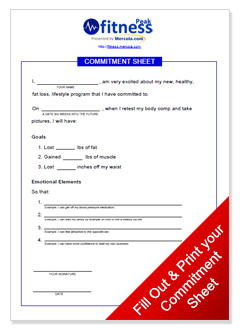You need to incorporate goal setting into your fitness program.1 Unfortunately, this is one of the most important elements of a fitness plan that many people overlook. Remember, people who have been most successful in their exercise routines are those who take the time to create a clear blueprint for themselves and their future.
Even if they start their fitness plan with a little skepticism, as long as they are able to follow the process of goal-setting and personal strategic planning, they are able to accomplish far more than they ever believed possible.
Developing the Mindset to Be Healthy Begins With Your Personal Values

Personal strategic planning begins with determining what it is you believe in and stand for: your values.
Your values lie at the very core of everything you are as a human being. They are the unifying principles and core beliefs of your personality and character. Your values, virtues, and inner beliefs are the axle around which the wheel of your life turns.
The first thing to remember is that your goal must be congruent with your personal belief system, or else you will not succeed at all. As long as being healthy is in your belief system, then you're congruent with the goal of mastering the dietary recommendations and working out according to plan.
Adapted from Brian Tracy's book "Maximum Achievement," here are 12 crucial steps that can help you align your values with your fitness goals:
- Develop the desire for health and being fit.
- Believe that you can be successful. In order to fully achieve anything, you must believe it is possible at a cellular level. Make your goals obtainable. You can even set up short-term goals that slowly but surely lead up to your long-term goal.
- Write it down. Until you put it in writing, it is a fantasy. Once in writing, your goal becomes concrete.
- Make a list of all the ways that you will benefit from achieving your goal, and get EMOTIONAL. The reasons may include having more energy, looking better, feeling great, or fitting into a dress. Review this on a regular basis, so you will stay motivated.
- Analyze your position or your starting point. This will give you a starting point or a baseline to measure your progress.
- Set a deadline. This is ideal for tangible goals, such as losing a certain amount of weight or lowering your blood pressure to the normal levels. Setting a deadline programs it into your cells to achieve that goal by a certain time, if not sooner. However, if your goal is intangible, such as optimizing your health, do not set a deadline. If you do set a deadline and fail to reach it, set another deadline.
- Make a list of obstacles that stand between you and the accomplishment of your goal. These obstacles may be internal or external. After listing all the possible obstacles that you can think of, re-list them in order of difficulty to overcome them.
- Identify the additional information you will need to achieve your goal. Setting a goal and going after it without knowing why you're going after it is a surefire way of stopping short of your goal.
- Make a list of all the people whose help and cooperation you will require. You're going to need the help and encouragement of others in achieving any goal. Carefully select only those who you know will support and encourage you in the fullest.
- Make a plan. Write out in detail what you want, when you want it, why you want it, and from where you're starting.
- Visualize. Visualization is a powerful tool. What you see is what you get. And what you eat provides the energy that enables you to become what you want. Picture yourself sitting at a table and only selecting foods that add life and health to the body.
- Make the decision in advance that you will never, ever, give up.
Clarity accounts for probably 80 percent of success and happiness. If you lack clarity in setting your goals, you will probably end up being frustrated and achieving less than what you visualized.
Make sure you review your goals every day to ensure that they are still significant to you. You may need to delete goals that are no longer as important as you once thought. Plan your goals thoroughly, ideally on paper, and work on them daily. This is the key to peak performance and maximum achievement.
Use My Commitment Sheet to Help You Set Your Fitness Goals
Here is another example of a goal-setting tool that I recommend you to use: the commitment sheet, created by fitness expert Darin Steen. This is a commitment that you make to yourself, which ties everything together.

This commitment sheet is written in the present tense, as if you've already accomplished your goals. This will help you become more motivated to work on your goals.
I advise you to read the commitment sheet out loud three times, with a positive tone in your voice, right before bedtime. Also read this sheet right upon waking in the morning. Remember, there is power in the spoken word. Stand up tall, with proper posture, and say it like you mean it.
I recommend these times of the day because you're in an alpha brain state, a prime time where you're more susceptible to auto suggestion or self-hypnosis. Your mind repeatedly reviews what you were thinking about at these two times as it "cleans the files" while you sleep. Set your fitness goals and program yourself to aim for a fitter and better you!